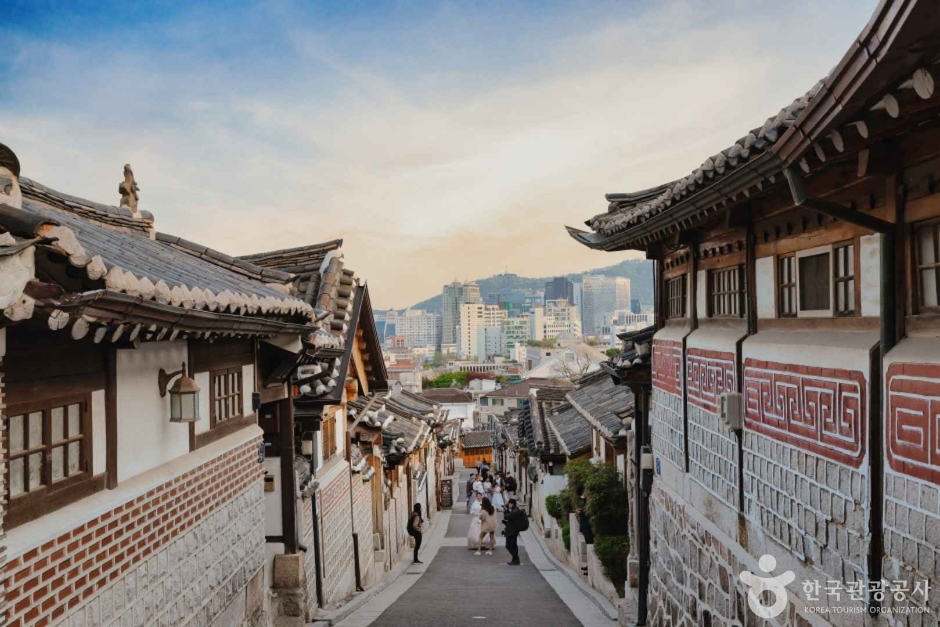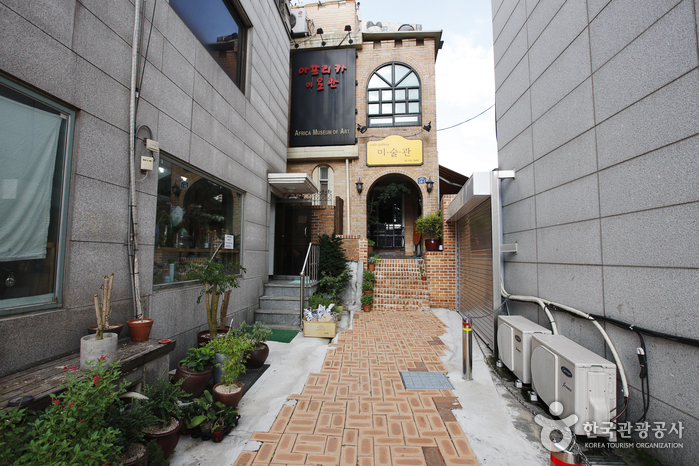Bukchon Hanok Village (북촌한옥마을)
5.1Km 2025-06-19
37 Gyedong-gil, Jongno-gu, Seoul
Surrounded by Gyeongbokgung Palace, Changdeokgung Palace and Jongmyo Shrine, Bukchon Hanok Village is home to hundreds of traditional houses, called hanok, that date back to the Joseon dynasty. The name Bukchon, which literally translates to "northern village," came about as the neighborhood lies north of two significant Seoul landmarks, Cheonggyecheon Stream and Jongno. Today, many of these hanoks operate as cultural centers, guesthouses, restaurants and tea houses, providing visitors with an opportunity to experience, learn and immerse themselves in traditional Korean culture. As Bukchon Hanok Village is an actual neighborhood with people's homes, visitors are advised to be respectful at all times while looking around.
Africa Museum of Art (아프리카미술관)
5.1Km 2022-10-26
24-1, Samcheong-ro, Jongno-gu, Seoul
+82-2-730-2430
The Africa Museum of Art was established with the purpose of hosting various art festivals and providing the grounds for researching various art themes. A major principle of the gallery is to promote works of art that actively attempt to explore the human mind.
Angyeong Seonsaengnim - Jongno Branch [Tax Refund Shop] (안경선생님 종로)
5.1Km 2024-04-18
1F, 393-1, Jong-ro, Jongno-gu, Seoul
-
CheongKwanJang - GS Tower Branch [Tax Refund Shop] (정관장 GS타워)
5.1Km 2024-04-18
1F, 508, Nonhyeon-ro, Gangnam-gu, Seoul
-
Irilju (일일주(日日酒))
5.1Km 2021-03-30
4, Sajik-ro 8-gil, Jongno-gu, Seoul
+82-2-738-1717
It is a delicious restaurant in Gwanghwamun with a good atmosphere. This Japanese (cuisine) restaurant is located in Jongno-gu, Seoul. The representative menu is salmon sashimi.
Olive Young - Yeoksam Station Branch [Tax Refund Shop] (올리브영 역삼역)
5.1Km 2024-04-17
138, Teheran-ro, Gangnam-gu, Seoul
-
London Bagel Museum Anguk Main Store (런던베이글뮤지엄 안국점)
5.1Km 2024-02-20
20 Bukchon-ro 4-gil, Jongno-gu, Seoul
London Bagel Museum is a bagel specialty shop adorned with a wooden-tone interior and a garland in the shape of the British flag. The bagels are made using the traditional British method of fermenting the dough, boiling it, and then baking it in the oven. Jambon butter sandwich bagel, made with sesame bagel filled with ham and butter, is a signature menu item.
LG Arts Center (LG아트센터)
5.1Km 2024-03-18
(LG Arts Center Seoul), 136, Magokjungang-ro, Gangseo-gu, Seoul
+82-2-2005-0114
LG Arts Center is a cultural complex space designed by Tadao Ando, a world-renowned architect. Its architectural excellence and design have won great acclaim. The main facilities contain performance halls, Art Lounge, and Studio. The LG SIGNATURE Hall, a multipurpose performance hall, has a capacity of 1,300. Its state-of-the-art facilities and sound design have drawn many visitors and performances to the complex.
Seoul Daehan Hospital (서울 대한의원)
5.1Km 2021-12-23
101, Daehak-ro, Jongno-gu, Seoul
+82-2-2148-1842
Daehanuiwon (Daehan Medical Center) is an antique two-story brick building within the grounds of Seoul National University Hospital. It was established under the direct administration of the Uijeongbu (State Council), combining the Gwangjewon (under the Home Ministry), Gyeongseong Medical School and the Korean Red Cross Hospital (under the Royal Household).
Built in the Madubong Hill area, this location where Hamchunwon, the outer garden of Changgyeonggung Palace, once stood in 1484 (15th year of King Seongjong), was also once the site of Gyeongmogung Palace, where King Jeongjo enshrined the mortuary tablet of his birth father Crown Prince Sado Seja in 1776 (the year King Jeongjo ascended to the throne).
These places that held importance for the royal family were destroyed as the Japanese built Gyeongseong Empire University in its place. In 1907, with the announcement of the plan to establish Daehan Medical Center, construction began on the main building, seven wards and affiliated buildings. Construction was completed in November 1908.
The Daehan Medical Center opened in Gwangjewon, but upon Japanese colonization in 1910, its name was changed to the Japanese Viceroyalty Hospital. In 1926, it was included as a part of Gyeongseongjeguk University to become a university hospital. Since the liberation of Korea in 1945, it has been a hospital affiliated with Seoul National University.


![Angyeong Seonsaengnim - Jongno Branch [Tax Refund Shop] (안경선생님 종로)](http://tong.visitkorea.or.kr/cms/resource/90/2878190_image2_1.jpg)
![Jaju [Tax Refund Shop] (자주)](http://tong.visitkorea.or.kr/cms/resource/65/2891065_image2_1.jpg)
![CheongKwanJang - GS Tower Branch [Tax Refund Shop] (정관장 GS타워)](http://tong.visitkorea.or.kr/cms/resource/56/2879856_image2_1.jpg)
![Olive Young - Yeoksam Station Branch [Tax Refund Shop] (올리브영 역삼역)](http://tong.visitkorea.or.kr/cms/resource/82/2879982_image2_1.jpg)


 English
English
 한국어
한국어 日本語
日本語 中文(简体)
中文(简体) Deutsch
Deutsch Français
Français Español
Español Русский
Русский